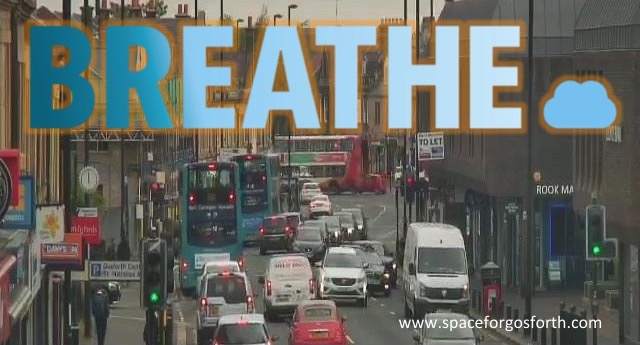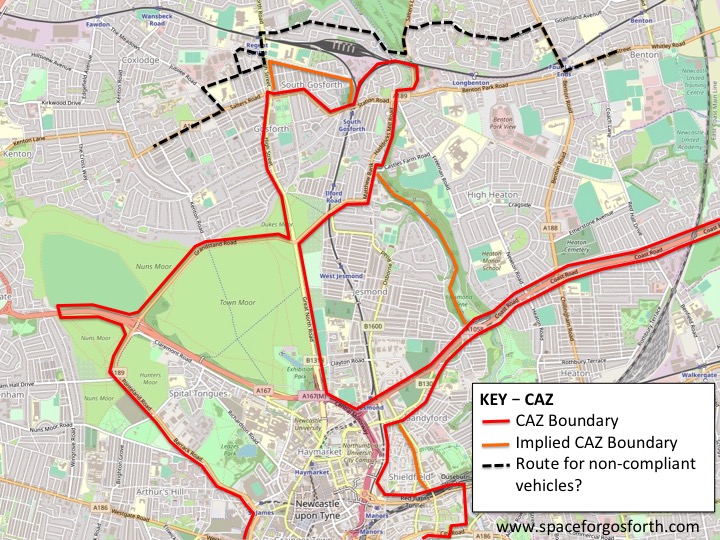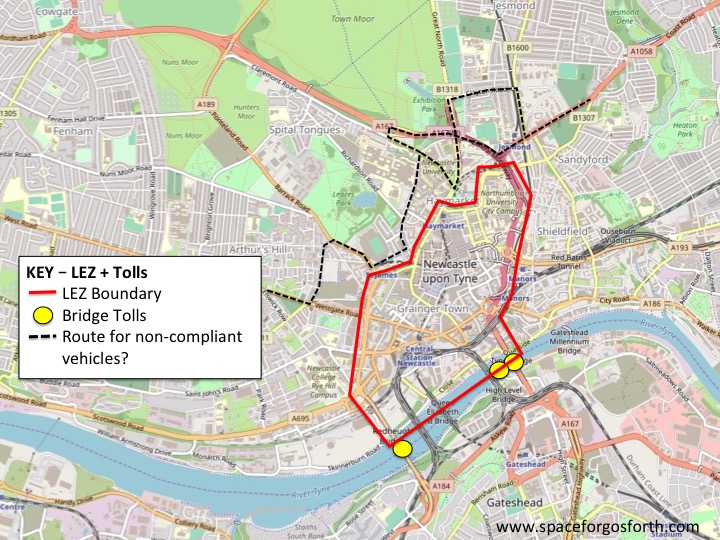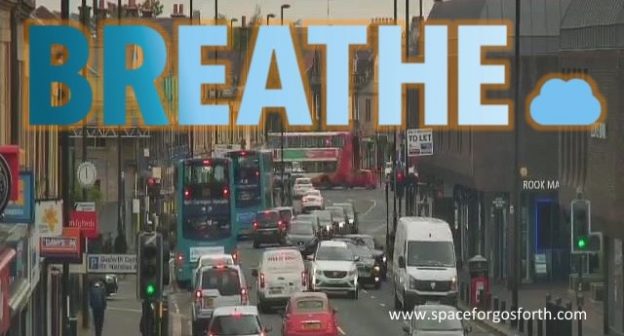
SPACE for Gosforth responded to the Council’s Air Quality consultation. This blog covers the part of the response in which we review the Council’s proposals. SPACE for Gosforth also made a number of proposals for how to achieve compliance by 2021, which we will publish separately.
Re: Achieving compliance with legal limits for nitrogen dioxide
Thank you for the opportunity to comment on the Council’s proposals to meet air quality limits in the shortest possible timescales.
Morally, it is indefensible that so many people have been made ill or have had their lives cut short by the Government’s failure to tackle air pollution.
The Council has an opportunity to rectify this now, to prioritise those people who are suffering today from the ill effects of air pollution, and those that will suffer in future if action is not taken.
These are our friends, our neighbours, and they are the people that you represent and work on behalf of.
It is important therefore that the plan is effective, that it ensures that compliance with limits is achieved in the shortest possible timescales, and that the route to compliance reduces exposure as quickly as possible.
We do not believe the Council’s current proposals achieve these aims. Substantially the major components are in place but much more could be done. In particular, the plan should contain sufficient measures to ensure that compliance by 2021 is the most likely outcome and additional measures to reduce exposure in the meantime.
Nobody wants air pollution but in the past, efforts stalled over disagreements about how to achieve better air quality or by prioritising “nice” but ineffective measures over those that work. We need to put that behind us now, as the law requires that the new plan must include the most effective measures.
The Council has a mandate, and an opportunity for action, and it must act urgently to achieve the best outcome for residents, businesses and visitors to Newcastle upon Tyne.
We look forward to discussing these proposals with you further and would welcome the opportunity to meet once you have had the opportunity to consider consultation feedback.
Yours sincerely,
SPACE for Gosforth
The Challenge / How we have approached the consultation
The Government has required that the Council produce a plan that (a) ensures compliance with legal limits for nitrogen dioxide in the shortest possible timescales and (b) provides a route to compliance that reduces exposure as quickly as possible. That plan cannot prioritise other factors e.g. cost, economy or popularity of measures ahead of effectiveness in meeting limits, but the Council can include in its plan measures such as walking and cycling improvements which are cheap, popular and economically beneficial.
SPACE for Gosforth has reviewed the Council’s plan and proposed additional measures to achieve the following objectives:
- To be effective – meeting limits and reducing exposure as quickly as possible; using measures that can be implemented and which evidence shows are likely to be effective;
- To be fair – applying the “polluter pays” principle; not disadvantaging the poorest who are most likely to be reliant on public transport and least likely to drive;
- To achieve wider benefits – e.g. safer, less noisy, more people-friendly streets; improving choice for how people travel; providing opportunities for every-day physical activity; boosting local retail; reducing greenhouse gases;
These are closely aligned to the Council’s legal obligation to meet air quality limits and its secondary policy objectives to improve public health, enable future economic growth and promote a fairer society.
Arguably the most effective plan will also be the fairest plan, as the least fair aspect of air pollution is that people are being made ill, and in some cases losing years from their lives, because Government failed to honour its commitment to meet air quality limits by 2010.
The proposed CAZ D
We understand that for both of the Council’s proposals, modelling predicts that legal limits will only be achieved across all of Newcastle, North Tyneside and Gateshead in 2023.
This itself is the most serious issue. Any plan that takes until 2023 to meet air quality limits cannot possibly be achieving the ‘shortest possible timescales’. We would also expect there to be a plan of measures to be introduced well before the compliance date to reduce exposure as quickly as possible in advance of the CAZ becoming operational.
The Strategic Case document only talks about the status as at 2021. For the CAZ D modelled it states:
- The CME and roads approaching Central Station would still be above limit values in 2021. [1.12.4]
- Limit values will not be met in Newcastle City Centre, particularly Percy Street. [1.12.7]
- Air quality on the A1 will be worse due to re-routing. [1.13.3]
- Air quality will become worse in some parts of Newcastle, although not to the extent that limits will be breached in those areas [1.15.2]
It is not clear from the Strategic Case how confident the Council are of this analysis, for example in relation to:
- The actual level of compliance for buses and taxis, modelled as being 100% compliance.
- DEFRA’s stated modelling accuracy of +-29%.
- The offsetting impact of the planned additional lane on the A1 and capacity increases at A1 junctions, the capacity increase planned for Haddricks Mill and new housing developments on the edge of the city with limited access to public transport or good quality cycling routes.
Any possible optimism bias in the plan needs to be addressed as the requirement is to produce a plan that will ensure compliance in the shortest possible timescales rather than one where compliance is just one of a number of possible outcomes.
The layout of the proposed CAZ also leads to two main issues, shown diagrammatically in figure 1 below:

Figure 1 – The Council’s proposed CAZ D
- The route around the northern edge of the CAZ for non-compliant vehicles appears to be made up of residential streets including Henry Street, Regent Road North and Hollywood Avenue.
- A number of areas including most of Jesmond, part of Shieldfield and the Gosforth ‘Terraces’ north of Church Road aren’t part of the CAZ but it is not possible to exit and re-enter those areas by car without travelling through the CAZ.
Point 1 seems at odds with the Government’s Air Quality Plan (Annex F), which says that the edge of a CAZ should be either (a) a natural boundary (e.g. a river), (b) a ring road where possible; or (c) if no ring-road then A-roads, where suitable or larger B roads. It also says smaller and residential roads should be avoided as far as possible.
The guidance saying that “If there are small clusters of exceedances over a larger area (metropolitan area) then several smaller distinct CAZs may be appropriate (rather than one large CAZ)” feels more relevant. It is unlikely that the charge needed for the north of the city will be the same as the charge needed for the city centre and Tyne crossings, so two separate CAZ might be more appropriate.
The Council’s analysis that air quality limits would not be met even with the charge of £12.50 for private vehicles, suggests that the necessary charge to meet limits would have to be higher still. While most people will accept that it is reasonable to pay for transport, such a high charge introduced without corresponding investment in public transport or cycle provision could potentially have adverse consequences. One potential consequence might be a greater use of taxis for shorter trips, as journeys within Newcastle generally cost less than £12.50. This would lead to even more emissions because of the extra miles driven by taxis between customer journeys.
The onus therefore sits with the Council to demonstrate that its alternative proposal will meet air quality limits in the same timescale and reduce exposure at least as quickly, or to propose additional measures that either reduce the need for such a high charge or mitigate the side effects.
Point 2 is relevant if residents of the CAZ will benefit from exemptions or support of some form but those outside would not. If the CAZ is to go ahead as proposed then it would seem reasonable to extend the exemptions or support to residents of Jesmond, Shieldfield and the Gosforth Terraces.
It is also possible the CAZ layout might lead to people parking just outside the CAZ because the boundaries are close to Regent Centre and other Metro stations.
The Council has raised the question of fairness on the basis that the less well off (if they do own a vehicle) are likely to own an older vehicle; hence the separate proposal for bridge tolls applying to all vehicles.
There is also the case that someone who travels once a week with an older car will pollute far less than a person who travels every day in a more modern ‘compliant’ vehicle, but will be charged more for the privilege.
The proposed LEZ and tolls
The proposed LEZ is most similar to the CAZ B modelling scenario in that it impacts the same types of vehicle and, in the modelling, taxis and buses are assumed to be 100% compliant. The Strategic Case states that for a CAZ B:
- The CME and roads approaching Central Station would still be above limit values in 2021 as per the CAZ D
- In addition the approach to the Tyne Bridge will also be above limit values in 2021. [1.12.2]
- Generally we would also expect that pollution levels elsewhere would be higher than for the CAZ D, other perhaps than on the A1.
We do not believe therefore that the LEZ option, by itself or with the addition of bridge tolls, reduces exposure as quickly as possible because the CAZ D will reduce exposure more quickly across a wider area. Given the choice of two plans, the Council must by law choose the one that reduces exposure most quickly. This would rule out the LEZ / tolls option unless it is supplemented by additional measures.
As with the CAZ proposal, there are also a number of modelling assumptions that suggest an unwarranted level of optimism in the analysis. Specifically:
- That buses and taxis will be 100% compliant with the LEZ standards.
- That all HGVs will be compliant with LEZ standards.
- That spare capacity generated by the bridge tolls on the Coast Road or Gosforth High Street won’t be claimed by other traffic as with the Council’s modelling of the Tyne Bridge. That new traffic may also be older or more polluting than the traffic it replaces.

Figure 2 – The Council’s proposed LEZ and bridge tolls
It is also concerning that the most likely route for non-compliant taxis and HGVs crossing the city centre will be via the main entrance to the RVI. Also air pollution on Strawberry Place exceeds the legal limit now so adding additional non-compliant traffic is unlikely to assist.
The proposed additional measures
The Council has proposed three additional measures:
- Timed restrictions for lorries and vans using Central Motorway
- Restricting access for all vehicles on Central Motorway
- Other measures e.g. install moss walls
We have not found evidence that any of these measures will be effective in combating air pollution.
Timed restrictions might reduce peak emissions but are likely to be less effective in reducing emissions averaged over the year, which is the limit that Newcastle needs to meet.
Restricting access could have the effect of just moving the issue to a different junction. An alternative approach to limit through traffic through the city centre, which is already Council policy, could achieve the same outcomes without re-engineering junctions.
Financial support and exemptions
We suggest applying the same tests to support and exemptions as we have applied to the measures themselves i.e. that they should:
• Support meeting air quality limits in the shortest possible timescales.
• Apply fairly; and
• Help to achieve wider benefits.
Support and exemptions that are required to meet air quality limits should be funded. An example might be the upgrade of bus engines to the latest EURO standard.
Support that might lead to more pollution should be avoided unless absolutely necessary. For example:
- It would be preferable to invest in a low/zero emission last-mile delivery service rather than pay to upgrade individual HGVs or LGVs.
- It would be preferable to encourage people to take public transport, or a combination of public transport and taxi, rather than pay to upgrade taxis. For example someone living in north Gosforth could get the Metro to Regent Centre and a taxi for the last part of their journey.
- It would be preferable to support a low-emission city centre shuttle bus to make it easier for people to use public transport rather than pay for car scrappage schemes.
The law requires that the Council’s plan achieves compliance by the soonest date possible, that it must reduce exposure as quickly as possible, and that meeting the value limits is not just possible, but likely. On that basis, exemptions would not be lawful if they might delay compliance, prevent exposure being reduced as quickly as possible or make achievement of limits less likely.
The Council also needs to consider that providing an exemption to one group might mean it needs to apply greater restrictions, which might include higher costs, for all others not in that group.
Consideration does need to be given to support people who have to travel when public transport is not operational.
To be fair, support should not depend on owning a current vehicle and should avoid giving one business a competitive advantage over another if the other has already upgraded its vehicles using its own funds.
Where it is provided, support should enable choice so that people can use public transport, walking or cycling depending on the journeys they need to take e.g. rather than be restricted to public transport. Options might include vouchers for an e-Bike or discounted car club membership.
Support should be focused on those that are most reliant on a car through no fault of their own, or for those that provide essential services for people who cannot travel any other way, for example hospital or community transport schemes. Support could include the provision of specialist zero-emission transport and could, for example, include support to expand the Cycling Without Age initiative. It could also include making public transport more accessible for people with disabilities.
If the Council wishes to support the less well off it needs to recognise that poorer people in general travel less than richer people, rely more on public transport, and will benefit if road-pricing revenues are used to enhance public transport, walking or cycling.
Support should not be ‘gameable’ e.g. if it would allow someone buys an old car for £500 and then trade it for £1000 worth of public transport vouchers.
Support should not make it cheaper for someone to continue to drive compared to if they were to use public transport for the same journey.
The Council should also be encouraging people to change how they travel now in advance of any LEZ or CAZ being implemented rather than waiting until it is implemented and then offering a grace period.
If a CAZ D is implemented then it would be reasonable to offer a reduced charge for a short grace period and / or additional support to residents and businesses within the CAZ who have fewer options to avoid the zone. Ideally support should be available prior to the CAZ being implemented, but without delaying that implementation.
Consideration would also need to be given to the operation of the RVI to ensure no unintended effects e.g. additional calls to the ambulance service because people who could make there own way to A&E do not wish to pay the charge. Care would need to be taken to ensure any support or exemptions given are fair on those that do not call an ambulance, in particular those that have to pay for a taxi or public transport because they don’t own their own vehicle.
Review of the Economic Case
The Economic Case is not a consideration for choosing which measures to use, other than where there are two options that are equally effective to meet air quality limits and which both reduce exposure as quickly as possible. If the Council is going to produce an economic assessment though, we would like to propose some ways in which that assessment might be improved to better reflect the likely outcome of the measures to be implemented.
Our suggestions are as follows.
- The assessment appears to mix costs to individuals with costs to government without taking into account that the charges would be revenue for (local) government that would offset the costs. Likewise new costs incurred e.g. in using public transport would be revenue for local public transport operators.
- Given the charges will be ring-fenced for investment in transport, it would be appropriate also to consider the gain from that investment rather than just the cost. For the best possible economic case investments could be targeted towards walking and cycling. In 2014 the Department of Transport produced a report that said typical benefit-cost ratios for walking and cycling investments are considerably greater than 4:1.
- The Royal College of Physicians estimated a benefit of £22.6bn nationally if air quality is improved. Even scaling for regional level, this is substantially higher than the Council’s estimate and we recommend the Council investigate to see if any benefits have been missed in its economic case.
- Given the ‘rule of half’ appears to account for a substantial part of the cost, a more detailed look at this aspect might be beneficial e.g.
- To look at situations where people save money or achieve other benefits compared to now e.g. if cycling or walking instead of driving, or if a family might no longer need to keep a second car so makes savings by using one car and other transport options.
- To look at the similar situation where journeys by car are still made but, for example, people car-share so using one vehicle instead of two, or trip-chain so doing one journey instead of two. Again, the benefit of the journey is achieved but at a lower cost.
- Similar to (1) and (2) to look at the situation where the benefit of the journey is still achieved but without travelling at all, for example someone might choose to work at home one day a week or hold a meeting on the telephone rather than face to face.
- To include the wider benefit of addressing market failure in vehicle transport. This market failure exists currently as the costs to an individual of travelling by private car are substantially less than the total costs including externalities such as pollution, noise, traffic collisions etc.
- To look at other cities where road pricing has been implemented to see what the actual costs and benefits are.
Appendix A. The legal requirement for clean air
Legal limits for air quality were put in place, initially via the 1997 National Air Quality Strategy, to protect the general public from illness and early death as a result of long-term exposure to air pollution.
The National Air Quality Objectives show that these limits should have been met in 2005.

The Air Quality Standards Regulations 2010 state that where levels of nitrogen dioxide exceed limit values, the Secretary of State must draw up and implement an air quality plan so as to achieve that limit value or target value. That air quality plan must include measures intended to ensure compliance with any relevant limit value within the shortest possible time.
In ClientEarth v Secretary of State for the Environment Food and Rural Affairs (Case No: CO/1508/2016), Mr Justice Garnham ruled that the Government’s then plan be quashed and that the Secretary of State must aim to achieve compliance by the soonest date possible, that she must choose a route to that objective which reduces exposure as quickly as possible, and that she must take steps which mean meeting the value limits is not just possible, but likely.
On 27 July 2017, the Government issued a direction to Newcastle City Council, North Tyneside Council and Gateshead Metropolitan Borough Council to produce a final plan by 31 December 2018 at the latest. In this plan the Councils should identify the preferred option for delivering compliance in the shortest possible time, and set out value for money considerations and implementation arrangements.
We note that the Councils’ current target for submitting a final plan is 12 July 2019, some seven months after this initial deadline, and fourteen years after the targets should have first been met.
In the Government’s UK Air Pollution Detail Plan it further clarifies that in order to qualify for funding the Councils’ plan must show that:
- It is likely to cause NO2 levels in the area to reach legal compliance within the shortest time possible (and provides a route to compliance which reduces exposure as quickly as possible);
- The effects and impacts on local residents and businesses have been assessed, including on disadvantaged groups, and there are no unintended consequences;
- Proposals that request UK government funding support demonstrate value for money; and
- The local measures have been carefully analysed using detailed local evidence and local air quality modelling tools and analysis methods, improving on the analysis at national level.
While it is reasonable for the Council to consider value for money, the measure or measures chosen must be the ones that will be most effective in meeting limits in the shortest possible timescale. Mr Justice Garnham was very clear when he said “I reject any suggestion that the state can have any regard to cost in fixing the target date for compliance or in determining the route by which the compliance can be achieved.”
See also

